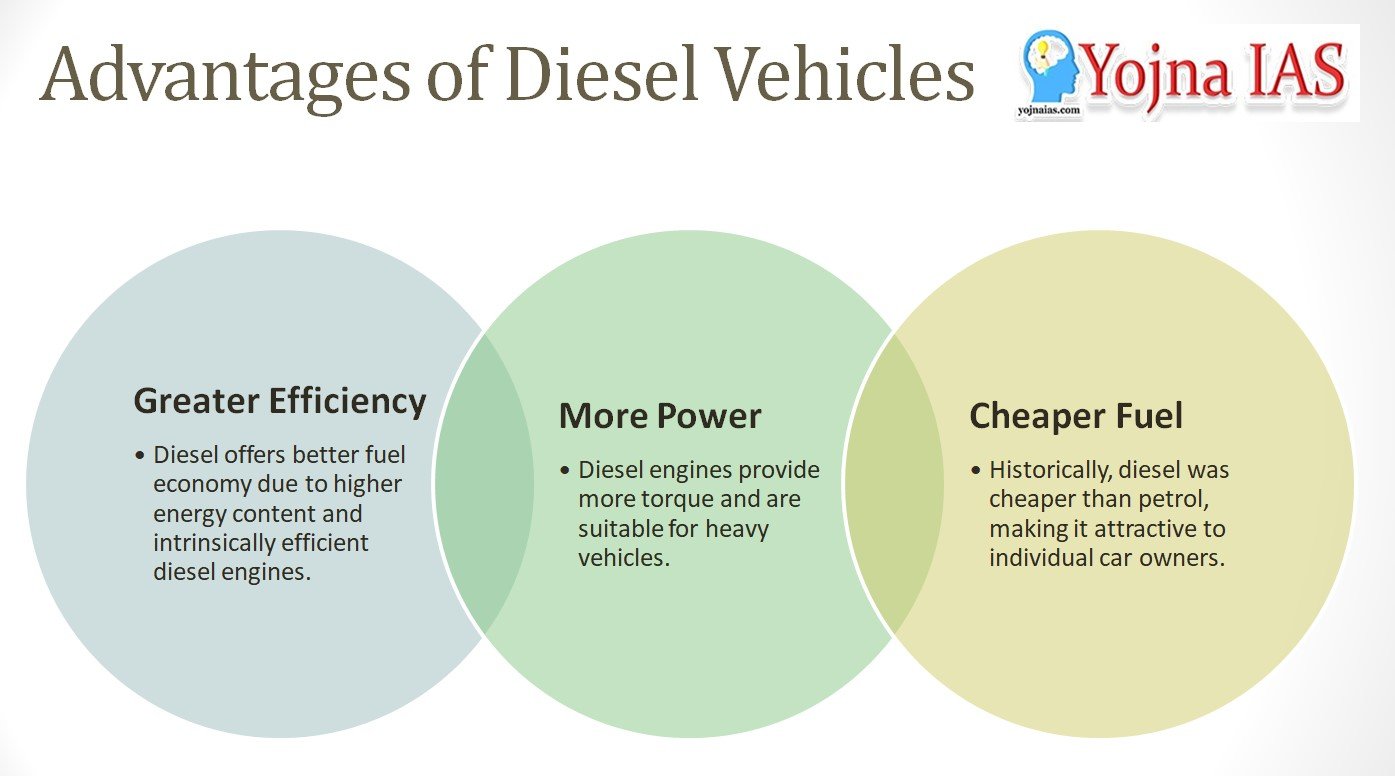15 Sep 2023 Proposed Additional Tax on Diesel Vehicles
This article covers “Daily Current Affairs” and the topic details “Proposed Additional Tax on Diesel Vehicles”. This topic has relevance in the “Indian Economy” section of the UPSC CSE exam.
For Prelims:
Diesel Vehicles
What are the advantages of Diesel Vehicles?
For Mains:
GS3: Indian Economy
Why in the news?
Recently, Road Transport Minister Nitin Gadkari emphasised shifting away from petrol and diesel fuels. He mentioned that if the use of diesel vehicles and generators persists, he might suggest a 10% GST increase as a “pollution tax” to the Finance Minister. However, he later clarified that there is currently no such government proposal.
The Pushback Against Diesel in India
- Government’s Green Goals: The Indian government aims to reduce greenhouse gas emissions and generate 40% of its electricity from renewables to achieve net-zero emissions by 2070.
- Taxation Strain: The government currently levies a 28% tax on diesel cars, accompanied by additional cess based on engine capacity.
- Emissions Dilemma: Diesel engines produce elevated levels of nitrogen oxides (NOx), raising environmental apprehensions. The 2015 Volkswagen scandal further exacerbated diesel’s global reputation.
- Fuel Efficiency Factor: Although diesel engines provide superior fuel economy and torque, the price distinction between diesel and petrol has shrunk since fuel price deregulation in 2014.
- Expensive upgrades: The transition to BS-VI emission norms from April 1, 2020, and the expensive upgrades required for diesel engines to comply with these standards prompted carmakers to exit the diesel market. They argued that skipping from BS-IV to BS-VI made diesel models economically unviable.
Status of Diesel Vehicles in India:
- Diesel’s Significant Share:
- Diesel constitutes approximately 40% of India’s petroleum product consumption, as per estimates from the Petroleum Planning & Analysis Cell.
- Transportation Dominance:
- Around 87% of total diesel sales serve the transport sector, with trucks and buses making up about 68% of diesel sales in India.
- Three states, namely Uttar Pradesh, Maharashtra, and Haryana, collectively account for nearly 40% of diesel sales in the country.
- Impact on Diesel Cars
-
- Maruti Suzuki, India’s largest car manufacturer, ceased production of diesel vehicles on April 1, 2020, and does not plan to re-enter this market.
- Tata Motors, Mahindra, and Honda no longer produce 1.2-litre diesel engines; they now offer diesel options only for 1.5-litre or larger engines.
- While some diesel variants are still available from Hyundai, Kia, and Toyota, most automakers have significantly reduced their diesel offerings since 2020.
- This has led to a decrease in the contribution of passenger vehicles to overall diesel demand, dropping from 28.5% in 2013 to 16.5%.
Advantages of Diesel Vehicles
- Greater Efficiency: Some individual users prefer diesel due to better fuel economy. Diesel has higher energy content per litre, and diesel engines are intrinsically efficient, utilizing higher compression ratios and no spark plugs.
- More Power: Diesel engines offer more torque, and are less prone to stalling, making them favoured for heavy vehicles and haulage.
- Cheaper Fuel: Historically, lower diesel prices than petrol were a significant attraction for individual car owners, with a substantial price difference of up to Rs 25 per litre at its peak.

Way forward:
- Promote electric vehicles (EVs): EVs are a clean and efficient alternative to diesel vehicles. The government can offer incentives to encourage people to switch to EVs, such as subsidies, tax breaks, and preferential parking.
- Improve public transportation: Public transportation is a more sustainable way to travel than private vehicles. The government can invest in expanding and improving public transportation options, such as buses, trains, and metros.
- Implement congestion pricing in cities: Congestion pricing charges drivers a fee to enter certain areas during peak traffic times. This can help to reduce traffic congestion and encourage people to use public transportation or other alternatives.
Sources: ‘Say bye to diesel’: Centre warns automakers of higher taxes in pollution fight – The Hindu
Download Yojna daily current affairs eng med 15th Sep 2023
Q1. With reference to Diesel Vehicles, consider the following statements:
- Diesel has a higher energy content per litre, making it intrinsically efficient.
- Diesel engines offer more torque, making them better suited for towing and hauling heavy loads.
- Diesel engines are generally less loud when compared to gasoline engines.
Which of the statements given above is/are correct?
(a) 1 and 2 only
(b) 2 and 3 only
(c) 3 only
(d) None
Answer: (a)
Q2. Consider the following :
- Taxing the use of fuels, such as biodiesel and ethanol
- Implementing congestion pricing in cities
- Encourage CNG and LPG
- Enforce stringent emission standards
How many of the above measures can help reduce diesel consumption in India?
(a) Only one
(b) Only two
(c) Only three
(d) All Four
Answer: (c)
Q3. Discuss the factors that have led to the pushback against diesel in India and the way forward to reduce diesel consumption in the country.


No Comments